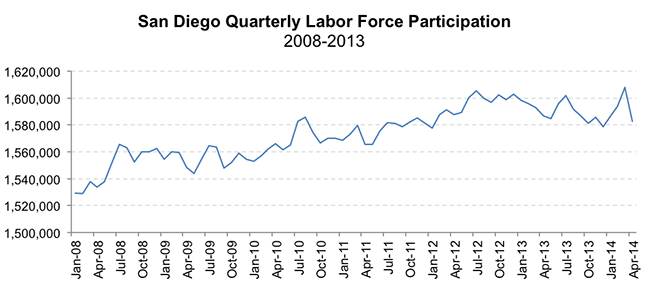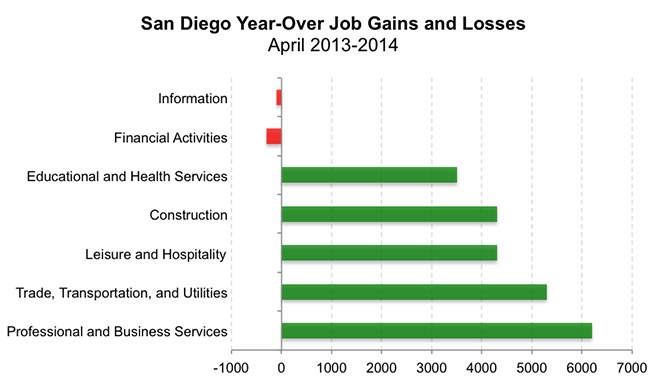California Employment Development Department (EDD) reported a drop in San Diego’s unemployment rate from 6.9 percent in March to 6.0 percent in April 2014.
This nearly 1 percent drop is largely due to declining labor force participation. According to the EDD, from March to April 2014, the number of unemployed individuals declined by 16,000 (14.4 percent). If the declining unemployment indicates that more individuals are obtaining jobs, then employment numbers should have increased. However, civilian employment actually decreased by 9,000 (0.6 percent), and civilian labor force decreased by 25,000 (1.6 percent). This suggests that job seekers left the labor market or stopped looking for work during this time period.

Each month, job seekers enter and drop out of the labor force for a numbers of reasons, including retirement or a weakening job market. However, April’s reduction of 25,000 job seekers marks the largest monthly drop in labor force participation since 1990, when 30,100 San Diegans stopped participating in the labor force.

Lower labor force participation numbers mean that less people are counted in the unemployment rate. This lowers the unemployment rate overall, which is calculated by dividing the number of labor force participants by the number of unemployed people. A drop in labor force participation may be due to a number of factors, such as the increasing amount of discouraged workers in San Diego (people who gave up looking for work entirely and dropped out of the labor force).
Seasonal employment causes labor force participation to change monthly, but year-over-year data compares similar time periods and eliminates seasonality. An analysis of the average annual labor force participation shows that labor force participation has gradually increased each year since 2000—some years with more gains than others. However, the only annual average with a decline in the past 13 years occurred most recently between 2012 and 2013, with 4,900 job seekers leaving the labor market.
Oddly, while the EDD reported a decline in labor force participation and employment, the EDD also reported an increase of jobs in the region. Nonfarm employment is up by 2,900 jobs (0.2 percent) over the month (from March to April 2014) and up 29,000 jobs (2.2 percent) over the 12-month period from April 2013 to April 2014.

Most notably, between March and April 2014, leisure and hospitality posted the greatest month-over gain of 3,100 additional jobs, and five industries posted month-over losses.

Eight industries reported job gains over the year (April 2013 to April 2014), with professional and business services reporting the greatest year-over gain of 6,200 jobs, and two sectors reported year-over losses.

The discrepancy between the loss of labor force and the gain in jobs may be attributed to the different data collection methods. Specifically, household surveys produce employment numbers and business surveys produce job numbers(1). Therefore, only continued observation of the labor force and employment over time will reveal how well the labor market is faring.
1. Horn, Jonathan. “SD unemployment drops to 6 percent.” UT San Diego. 16 May 2014.
